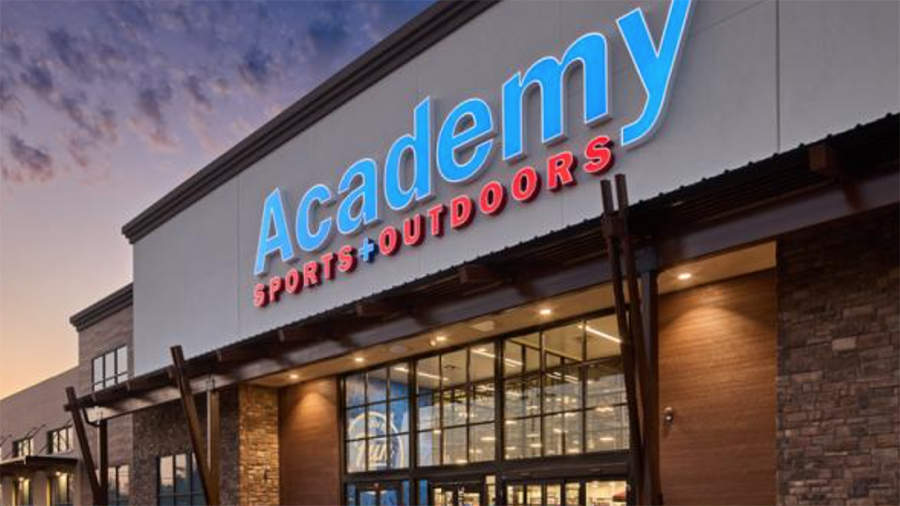The analyst community remained bullish on Academy Sports following its Investor Day presentation that saw the retailer deliver an ambitious plan to expand its store base by 50 percent by 2027.
Shares on the day of the event fell $3.85 to $62.58 with the decline attributed to near-term concerns. Academy reiterated its guidance for 2023 but again cautioned the first half of the year would be challenging against tough comparisons.
Shares are still well ahead of the $52.54 level reached at the close of 2022 and have vaulted nearly five-fold from its October-2020 initial public offering price of $13.
Highlights of the new five-year plan through 2027 include:
- Academy expects to open 120-to-140 new stores over the next five years through 2027, expanding its store base by 50 percent in existing and new markets. The expansion will lead to Academy reaching around 400 stores and officials cited the long-term potential to have more than 800.
- Sales are expected to expand from $6.4 billion in 2022 to $10 billion in 2027. The new store openings are expected to add between $2.4 billion to $2.8 billion in sales, omnichannel benefits are expected to add between $700 million and $900 million in sales and improving productivity from existing stores is expected to add $500 million to $700 million in sales. Online penetration is expected to expand to more than 15 percent of revenue from about 10 percent.
- Comps are expected to be in the low-to-mid single digits, resulting in an overall 10 percent top-line compound annual growth rate (CAGR) over its five-year plan.
- Gross margins are planned to land in the range of 34.0 percent to 34.5 percent each year over the five-year plan, which compares with 34.9 percent on an adjusted basis in 2022.
- Merchandise margins are expected to improve 40 basis points primarily due to continuous process improvement, including better planning and allocation, better buying optimization or localization, enhanced clearance efforts, and upgraded labor scheduling.
- Academy’s merchandise mix is also expected to benefit as higher-margin apparel and footwear categories grow faster than outdoor and sports & recreation categories. Private-label apparel expansion is also expected to improve gross margins.
- Supply chain improvements are expected to benefit margins by 100 basis points due to its new warehouse management system and leveraging supply chain visibility to drive transportation efficiencies.
Analysts Take
Below, some snapshots of Wall Street’s view of the Investor Day event and Academy.
TD Cowen kept its “Outperform” rating and price target at $78.
Cowen’s John Kernan wrote, “Management of Academy Sports gave a confident presentation that highlighted competitive advantages – a service-led store model, improving supply chain execution, omnichannel capabilities, experienced management team and unparalleled value.”
Kernan’s note particularly called out the session by Sherry Harriman, Academy’s SVP Logistics & Supply Chain, who detailed how a new warehouse management system drive efficiencies in pallet space and generate about 5 percent in cost savings. Increased efficiency in Academy’s supply chain is also expected to expand capacity by about 20 percent. Overall, enhanced warehouse management practices and efficiencies are expected to result in a 45 percent decrease in lead times to support in-store levels and a 30 percent improvement in e-commerce fulfillment costs. A fourth distribution center is expected to open in late 2025 or early 2026 to further store growth.
From a demand standpoint, Kernan noted that preference for shopping Academy Sports within Cowen’s proprietary survey accelerated through 2022, averaging 9.3 percent for the year, which increased further YTD in 2023 to an average of 10.2 percent.
Kernan wrote, “As Academy shifts towards a growth mindset, bringing this store experience to adjacent markets is expected to allow ASO to take share in the $175B sporting goods and outdoor industry.”
Stephens reiterated its “Overweight” rating at a target price of $80.
Analyst Daniel Imbro wrote, “We would use the pullback in shares as a buying opportunity, as we left the meeting more positive on the long-term earnings power of the business.”
Imbro noted that the improving growth backdrop will be fueled by accelerating unit growth and a higher organic growth outlook than previously messaged. He noted that investor conversations suggest that there is concern around the sustainability of certain categories that received a surge during the pandemic, but Academy officials stressed that many categories that normalized lower last year have stabilized in weekly sales volume recently, suggesting a rebasing higher. Imbro wrote, “Notably, categories such as golf remain robust and well above pre-COVID levels. The unit growth has enabled ASO to grow into new brands, many of which will drive sustained growth relative to pre-pandemic levels.”
He added that the outlook calls for modest growth at existing stores appears achievable due to the favorable population growth and ongoing business improvements. The analyst also called out Academy’s improving margin rate and strong free cash flow. Imbro noted that Academy’s shares are trading slightly below its closest competitor, Dick’s Sporting Goods, but he believes shares should be seeing a valuation closer to those earned by growth stocks.
Wells Fargo kept its “Overweight” rating at a $75 price target.
Wells Fargo’s analyst Kate Fitzsimons wrote, “The ASO analyst day affirmed our bullish view given store growth opportunities, margin buffers and strong FCFs [free cash flow]. That said, tougher 1Q comments are likely to keep investors on the sidelines NT until they get comfort with the 2H23/LT comp trajectory.”
Fitzsimons said a key theme at the event was the progress Academy has made over the last several years, especially since 2018/2019 on talent, systems, and execution in order to build a “far healthier” business. She remains bullish on the stock due to Academy’s potential for growth and further margin improvement with the help of retail “best practices” put in place by CEO Ken Hicks.
She wrote, “While the targets are not unambitious, we see value out of the ASO story as: 1) there is clear opportunity for productive store growth; 2) the biggest margin buffers (esp. supply chain) are levers under the company’s control, while growth investments can be ratcheted down if need be; and 3) buybacks can support EPS. Our $10.50 2027E is below LT targets (on $8.5B in revs) but still suggests a stock $100+ in the next few years.”
Wedbush maintained its “Outperform” rating while raising its price target to $75 from $73.
Wedbush analyst Seth Basham wrote, “We came away from ASO’s analyst and investor meeting yesterday impressed by the quality of ASO’s business, its leadership under CEO Ken Hicks, and the company’s drivers to achieve high-teens earnings growth from 2024-2027 as it takes market share in a fragmented $175b+ sporting goods industry.”
He noted that Academy’s improved value proposition marked by improved assortments, the development of its online business and an increased consumer focus on health and wellness during the pandemic led the company to achieve its long-term 2023 goals, initially set in 2018, a year earlier than anticipated.
Basham stated, “While there may be concern about near-term sales weakness in 1H23, we believe that ASO’s sales trends should improve in 2H23 and the company should be able to meet full-year 2023 guidance that it reiterated at the meeting. Moreover, we look favorably on the company’s long-term targets with a clear line of sight as ASO continues to transition into a top-tier sporting goods retailer.”
Bank of America Securities reiterated its “Buy” rating and lifted its price target to $85 from $80.
Analyst Robert Ohmes said top-line growth at Academy is expected to be driven by store growth and elevated merchandise assortment. He wrote, “We visited ASO’s new prototype store format which featured enhanced bold merchandise presentations with elevated product allocations from key brands (Nike Epic Infinity React), improved sight lines, especially with the new center of the store entrance and power aisle and new queuing checkout format which is improving front-end sales by 8 percent (with 141 queue-checkout stores by year-end). ASO also highlighted its continued focus on improving its “better & best” categories outside of key national brands.”
Ohmes sees supply chain initiatives as the next opportunity for structural margin uplift with digital (e.g., new customer data software) and store productivity initiatives also potentially driving additional margin upside.
JP Morgan kept its “Overweight” rating at a target price of $70.
Analyst Christopher Horvers wrote, “Overall, ASO’s Analyst Day represented a bit of a pivot in the story as the low hanging fruit stage of CEO Ken Hicks and team’s past five years shifts to medium hanging fruit and store growth with a higher degree of investment albeit with significant potential FCF. Indeed, the ‘retail 101’ turnaround that began in 2018 was one of improved people, execution/culture, and a big step up in merchandising clarity/systems usage (i.e., assortment localization, merchandise planning, pricing, and promotion modules, and space productivity efforts). Looking ahead, while we still see low-hanging fruit around leveraging data to better target consumers, and to improve the Omni-customer experience, the supply chain efforts (where we see potential margin upside) are longer-tailed with customer acquisition/topline growth more a store expansion strategy. We would emphasize, however, that ASO still has a lot of opportunity to catch up to most best-in-class retailers in key areas (e.g., omni and supply chain), suggesting an upward bias to its plans over time.”
UBS reiterated its “Buy” rating and raised its price target to $78 from $76.
Analyst Michael Lasser wrote, “We believe ASO laid out an achievable plan to drive its P&L over the next few years. We believe ASO is well positioned to gain share and is making the right strategic decisions to do so. Further, ASO’s operational excellence has yielded structural margin gains that should not fall below 34.0 percent on an annual basis. Finally, while the near-term backdrop is uncertain, we believe ASO’s improved assortment, better customer experience and best-in-class value proposition should enable it to perform well even in a challenged environment.”
Baird kept its “Outperform” rating at an $80 price target.
Baird analyst Justin Kleber said the “investor meeting reinforced our positive view on shares. Specifically, ASO has several idiosyncratic initiatives on tap to further improve existing asset productivity and sustain EBIT margins well above pre-pandemic levels.
Kleber noted that Academy’s management team at the meeting stressed the benefits of its “best-in-sector unit economics,” as well as applying learnings from the 2022 openings to continuously improve future openings. Key productivity enhancements on display during a store tour included key brand callouts, lower sight lines/better navigation, and an improved checkout process (customer queue lane).
Kleber wrote, “With best-in-sector store productivity and exposure to some of the fastest growing MSAs (metropolitan statistical areas), we see multiple expansion optionality as investors gain confidence in ASO’s ability to execute against its whitespace opportunity.”
Kleber further noted that Academy highlighted incremental initiatives to further improve existing asset productivity, including increasing online penetration through an enhanced mobile app and developing endless aisle capabilities, refining merchandise localization and leveraging a new customer data platform to better target customers. Kleber said, “Looking ahead, advanced customer data analytics, loyalty, and supply chain efficiencies represent productivity unlocks still on tap as ASO continues its transformation into a best-in-class retailer.”
Evercore ISI maintained its “Outperform” rating and keep its price target at $75.
Analyst Greg Melich noted that capital expenditures will double under the 2027 plan due to investments in new stores and a new distribution center as well as higher e-commerce fulfillment costs. He further said that Academy will likely see a “rough” first half of the current year. However, he sees “more upside than downside to the stock” as Academy’s Investor Day showcased the retailer’s potential for growth and strong free cash flow generation.
He said improving service and productivity in stores, strengthening merchandising through national brand partnerships, complemented by private brands, attracting new customers, and increasing existing customer spending should ensure that adjusted operating margins can stay above 13 percent by 2027, which is 900 basis points above pre-pandemic 2019’s level of 4.3 percent.
Melich wrote, “Bottom Line: Academy gained market share and expanded margins/earnings during the pandemic while building a solid foundation to grow off of. We believe down comps and down margins in 2023 are more representative of a normalization process after outsized comps and margin gains during the pandemic than a deterioration of the core business. With plenty of FCF (free cash flow) despite accelerating sq ft growth, combined with shareholder returns, the risk/reward at 7.5x P/E is compelling.”
Photo courtesy Academy
















